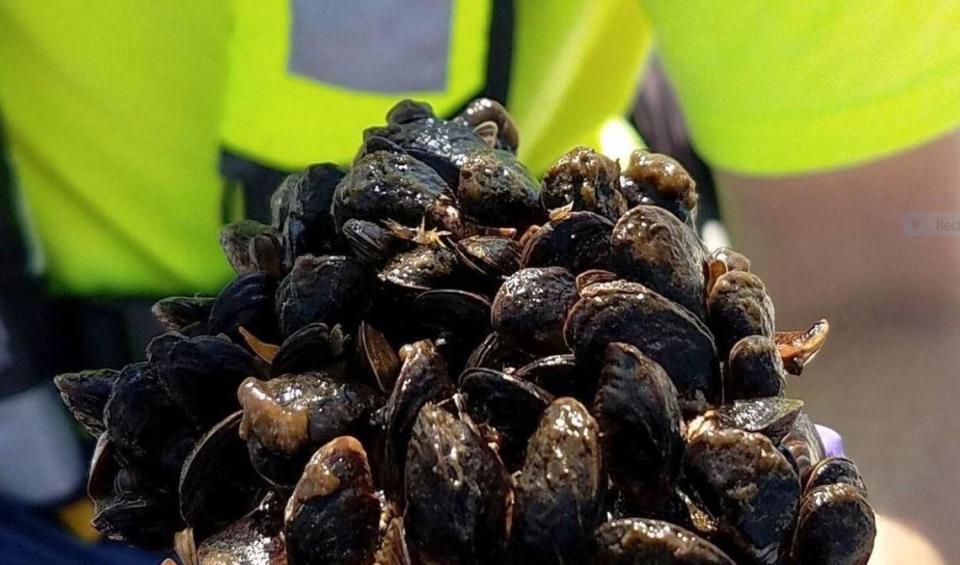US declares species once found in Illinois extinct. What does it mean for water quality?
The U.S. Fish and Wildlife Service recently declared 21 species extinct, including an environmentally significant one previously found in the Land of Lincoln.
The tubercled-blossom pearly mussel was native to Illinois, as well as seven other states across the nation. It was one of the first to be placed on the Endangered Species Act in 1976, but had not been seen for years prior to its recent delisting.
“We haven’t seen it in Illinois or in the United States in quite a few decades,” Illinois Department of Natural Resources aquatic ecologist Brian Metzke told the News-Democrat recently.
The last confirmed sighting of the tubercled-blossom pearly mussel in the U.S. was in 1969, according to the USFWS, but it likely hasn’t been present in Illinois since before the 1960s, Metzke said.
This species was one of eight mussels declared extinct by USFWS in October.
Mussels perform several functions important to humans, including being a great ecological indicator and filtering the water supply.
“Estimates vary, but a single mussel can probably filter up to 20 gallons of water in a single day,” Metzke said.
Fewer mussels in our environment likely means water quality will worsen, Metzke added, though it can be difficult to estimate the exact effect as ecologists don’t have extensive records of what the water environment looked like when the mussels were more abundant.
“They’re like little miniature water purifiers, so they’re really a very important part of aquatic communities,” USFWS spokesperson Georgia Parham said.
Illinois used to be home to about 80 native mussel species, but some have not been seen in decades and many face the risk of extinction.
“Most mussels that we have in Illinois are imperiled or vulnerable to some degree in terms of their conservation status,” Metzke said.
Mussel populations have seen “drastic declines” in Illinois and across the nation, the state’s department of natural resources reports, and only 59 mussel species have been seen in the state since 1970.
An ideal mussel habitat includes clean, clear, flowing water and stable substrates, and the mollusks are intolerant of pollution. Habitat destruction, dam construction and draining of wetlands all pose risks to the livelihood of individual mussels and species.
In addition to habitat loss, invasive species have also contributed to the decline of mussel populations. The invasive zebra mussel species harms native mollusks by directly colonizing them and eating their food.

“They basically starve our native mussels to death,” Metzke said.
Another invasive species threatening to drive mussels into extinction is black carp, which have been reported in the Mississippi River basin. The fish eat native mussels, though the full extent of how dangerous they may be to mussel survival is still being investigated.
What’s being done to save mussels?
Although mussels face a variety of threats and their numbers have declined, state and federal officials are spearheading programs to support their survival and even potentially revive critically endangered species.
Ecologists at fish hatcheries across the nation are working to propagate native mussels, raise the juveniles and release them into the wild. Officials with the USFWS, the Illinois Department of Natural Resources and other state agencies participate in propagation programs, and they’ve been effective in many cases.
Staff with the Virginia Department of Wildlife Resources Aquatic Wildlife Conservation Center were able to raise nearly 1,000 juvenile mussels that survived on different host species, the USFWS reported in an Oct. 26 release. Officials plan to release the juvenile mussels throughout Virginia’s Powell River.
How are species declared extinct?
The USFWS is tasked with maintaining an endangered species list, as well as determining when a species is no longer found in the wild. The agency considers a variety of factors, including the best available scientific information when making a decision, Parham said.
The federal governmental agency works with state departments to identify documented sightings of endangered species and also conducts five-year reviews to maintain species’ current status, move them off of the endangered species list due to recovery or declare them extinct.
It’s not overly common for federal officials to declare a species extinct, Parham continued, as they conduct extensive research to look for remnant populations.
Eight bird species native to Hawaii were among the 21 species recently declared extinct. Here’s a full list of the species declared extinct by USFWS Oct. 16:
Tubercled-blossom pearly mussel
Flag pigtoe (mussel, last confirmed sighting in 1984)
Southern acornshell (mussel, last confirmed sighting in 1973)
Stirrupshell (mussel, last confirmed sighting in 1986)
Upland combshell (mussel, last confirmed sighting in the mid 1980s)
Green-blossom pearly mussel (last confirmed sighting in 1982)
Turgid-blossom pearly mussel (last confirmed sighting in 1972)
Yellow-blossom pearly mussel (last confirmed sighting in 1966)
Little Mariana fruit bat (last confirmed sighting in 1968)
Bachman’s warbler (bird, last confirmed sighting in 1980s)
Bridled white-eye (bird, last confirmed sighting in 1983)
Kauai akialoa (bird, last confirmed sighting in 1960s)
Kauai nukupuu (bird, last confirmed sighting in 1899 )
Kauaʻi ʻōʻō (bird, last confirmed sighting in 1987)
Large Kauai thrush (bird, last confirmed sighting in 1987)
Maui ākepa (bird, last confirmed sighting in 1988)
Maui nukupuʻu (bird, last confirmed sighting in 1996)
Molokai creeper (bird, last confirmed sighting in 1963)
Po`ouli (bird, last confirmed sighting in 2004)
San Marcos gambusia (fish, last confirmed sighting in 1983)
Scioto madtom (fish, last confirmed sighting in 1957)

